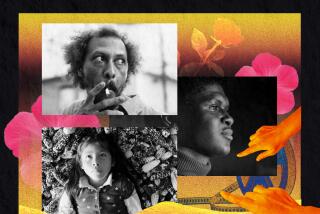Margot Benacerraf’s film ‘Araya’ returns
- Share via
When director Margot Benacerraf set out to film an isolated community of salt harvesters on Venezuela’s Caribbean coast 50 years ago, she said, “I wanted to do more than a simple documentary.”
Her larger objective was “to record, to register everything that was going on, because it interested me, the disappearance of this world that I filmed,” Benacerraf said recently, speaking in Spanish by phone from New York.
The fruits of her labor, the lyrical 82-minute, black-and-white film “Araya,” had a sensational initial reception at its 1959 premiere at the Cannes Film Festival, where it shared the International Critics Prize with Alain Resnais’ French New Wave landmark “Hiroshima, Mon Amour.”
Then, over the next five decades, “Araya” seemed to disappear into a cultural black hole until it was rediscovered, remastered and reissued by Milestone Film & Video. It opens, or one might say reopens, today at the Nuart Theatre in Los Angeles.
“Araya” evokes not only the films of Luis Buñuel and Glauber Rocha but also the stories of Gabriel García Márquez and Sebastião Salgado’s photographs of South American laborers scurrying like ants over giant swathes of man-molded earth.
Yet the film’s insistence on hewing to a lyrical, nontraditional narrative style may help explain why it was misunderstood by some critics at the time of its debut, and neglected for so many decades afterward.
“I don’t think people truly understand the film as a poem,” said Dennis Doros, who runs Milestone Film & Video with his wife, Amy Heller. “People want to label films and put films into categories. They automatically put it into ‘documentary with narrator.’ ”
A peculiar set of historical and geographical circumstances created the world that “Araya” captures. Some of the harvesters that Benacerraf depicted were descended from families that have worked the same salt marshes since the days of the Spanish colonizers in the 1500s. In all that time, neither the technology nor the hard, impoverished conditions of the workers’ lives had notably changed.
“It was an absolutely isolated region, from Venezuela, from the world,” Benacerraf said. “It was . . . outside of all contact with civilization.”
Benacerraf said she originally conceived “Araya” as part of a triptych that would form a larger feature film depicting life in three areas of Venezuela: the Andes mountains, the plains and the coast. But for the coastal segment, she didn’t want to show a stereotypical “exotic” landscape, lush with palm trees. Her search led her to the arid Arayan peninsula.
In this Sisyphean reality of endless grueling labor with little material advancement to show for it, Benacerraf discerned a metaphor for all of Latin America. In recent years, she said, many small-town Latin communities such as the one that “Araya” represents had to pass swiftly and shockingly from a pre-industrial to an industrial era without benefit of a transitional stage.
Two years ago, Benacerraf returned to Araya at the invitation of a French television crew. The descendants of some of the people she’d filmed received her warmly.
But the town itself was ghostly. Families that lost their jobs when machinery replaced them had fled. The filmmaker’s conclusion was the same as it had been half a century earlier: Industrialization “didn’t bring any important human benefit to the region.”
More to Read
The biggest entertainment stories
Get our big stories about Hollywood, film, television, music, arts, culture and more right in your inbox as soon as they publish.
You may occasionally receive promotional content from the Los Angeles Times.











